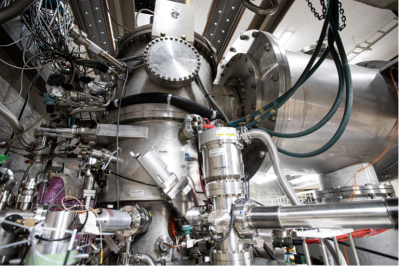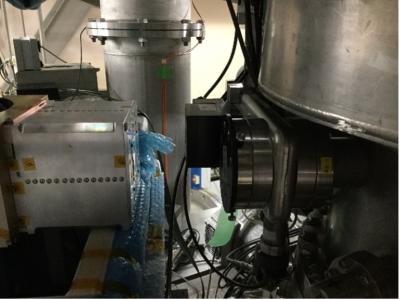March 17, 2023
Kavli Institute for the Physics and Mathematics of the Universe (Kavli IPMU)
The University of Electro-Communications
Tsukuba University
National Institute for Fusion Science
By adapting technology used for gamma-ray astronomy, a group of experimental researchers has found that X-ray transitions previously thought to have been unpolarized according to atomic physics, are in fact highly polarized, reports a new study published in Physical Review Letters on 15 March.
When electrons recombine with highly charged ions, X-ray polarization becomes important for testing fundamental atomic physics involving relativistic and quantum electrodynamics effects. But to date, experimental researchers have been challenged by the technical difficulties these experiments require.
A team of researchers led by the University of Electro-Communications Insitute for Laser Science Professor Nobuyuki Nakamura, and including Kavli Institute for the Physics and Mathematics of the Universe (Kavli IPMU) Professor Tadayuki Takahashi and graduate student Yutaka Tsuzuki, and Institute of Space and Astronautical Science (ISAS/JAXA) Associate Professor Shin Watanabe, successfully combined two state-of-the-art instruments and technologies to measure the polarization of high-energy X-rays emitted when highly charged ions capture high-energy electrons.


The first is the electron beam ion trap the Tokyo-EBIT, which is one of the world's leading highly charged ion generators and experimental instruments owned by the University of Electro-Communications, and the second is the Si/CdTe Compton Camera for high-energy X-rays, which was developed for astronomical observations mainly at ISAS/JAXA and improved for this research.
The technology behind the Si/CdTe Compton Camera was originally developed by a team led by Takahashi to study X-rays and gamma rays in the universe released by highly energized black holes, supernovae and galaxy clusters, and was built into the Japan Aerospace Exploration Agency (JAXA) ASTRO-H satellite, launched in 2016.
Takahashi had been looking for a way to adapt the technology to other fields. After a meeting with Nakamura, Takahashi began to work on designing the X-ray polarization experiment and implementing the Si/CdTe Compton Camera into the method.
Tsuzuki carried out a large part of the calibration and simulation of the Compton camera.
Tsukuba University Associate Professor Xiao-Min Tong, Institute for Applied Physics and Computational Mathematics Distinguished Research Fellow Xiang Gao, and National Institute for Fusion Science Associate Professor Daiji Kato made a theoretical analysis of the results, which revealed that the unexpectedly large polarization observed in the experiment was the result of quantum interference effects, where quantum mechanical probability waves interfere with each other. Normally, the initial states of two waves must be equal in order for interference to occur, but it was also revealed that the observed polarization was caused by a peculiar interference effect between two waves with different angular momenta.
Details of the team’s results were published in Physical Review Letters published on 15 March.
For the full press release by The University of Electro-Communications (in Japanese only), click here.
Paper details
Journal: Physical Review Letters
Paper title: Strong Polarization of a J=1/2 to 1/2 Transition Arising from Unexpectedly Large Quantum Interference
Authors: Nobuyuki Nakamura (1), Naoki Numadate (1), Simpei Oishi (1), Xiao-Min Tong (2), Xiang Gao (3), Daiji Kato (4, 5), Hirokazu Odaka (6, 7), Tadayuki Takahashi (7, 6), Yutaka Tsuzuki (6, 7), Yuusuke Uchida (8), Hirofumi Watanabe (9), Shin Watanabe (10, 7), and Hiroki Yoneda (11)
Author affiliations
1 Institute for Laser Science, The University of Electro-Communications, Tokyo 182-8585, Japan
2 Center for Computational Sciences, University of Tsukuba, Ibaraki 305-8573, Japan
3 Institute for Applied Physics and Computational Mathematics, Beijing 100088, China
4 National Institute for Fusion Science, Toki, Gifu 509-5292, Japan
5 Interdisciplinary Graduate School of Engineering Sciences, Kyushu University, Fukuoka 8 16-8580, Japan
6 Department of Physics, The University of Tokyo, Tokyo 113-0033, Japan
7 Kavli Institute for the Physics and Mathematics of the Universe (WPI), Institutes for Advanced Study (UTIAS), The University of Tokyo, Chiba 277-8583, Japan
8 Department of Physics, School of Science and Technology, Tokyo University of Science, Chiba 278-8510, Japan
9 Center of Applied Superconductivity and Sustainable Energy Research, Chubu University, Aichi 487-8501, Japan
10 Institute of Space and Astronautical Science, Japan Aerospace Exploration Agency, Kanagawa 252-5210, Japan 11RIKEN Nishina Center, Saitama 351-0198, Japan
DOI: 10.1103/PhysRevLett.130.113001 (published 15 March 2023)
Paper abstract (Physical Review Letters)
Media contact
Motoko Kakubayashi
Press officer
Kavli Institute for the Physics and Mathematics of the Universe (Kavli IPMU), The University of Tokyo
E-mail:press_at_ipmu.jp
* Please change _at_ to @
Related links
Takahashi Laboratory website (in Japanese)






